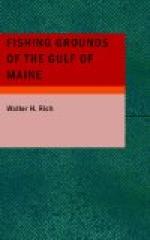The grounds as drawn are not meant to include any definite depth curve but are meant to show certain fishing areas. It is known of course, that most species frequent the shallows and the deep water at the various seasons: also, that certain other species are found on the deeper soundings during virtually all the year. Thus, if a given area appears as a larger ground than is shown upon other charts made for navigating purposes, often this is because we have included in it a cusk ground or a hake bottom lying adjacent to the shoal as charted.
A large number of these grounds have been described before by G. Browne Goode and others, and where possible their work has been used as a basis for the present paper, with any further information or the noting of any changed condition of the grounds or difference in fishing methods employed upon them that was obtainable.
Grateful acknowledgment is hereby made to the many captains who furnished information that, made the drawing of the charts possible and for the facts used in the descriptions of the fishing grounds.
With the offshore banks, particularly with the Georges area and Browns Bank and to a certain extent, also, the western portion of the Inner Grounds, the writer has had a considerable personal acquaintance from which to draw.
For the geographical and historical data the writer has quoted freely from various modern authors, who, in their turn, have drawn their facts from older records. Among those quoted are Holmes’s American Annals; Parkman’s Pioneers of France in the New World; Southgates History of Scarburo; Abbott and Elwell’s History of Maine; Willis’s History of Maine; Sabine’s Report on the Principal Fisheries of the American Seas; A History of the Discovery of the East Coast of North America, by Dr. John G. Kohl, of Bremen, Germany; various chapters of Hakluyt’s Voyages; the Journal of John Jocelyn, Gent.; and New England Trials of the famous Captain John Smith.
GULF OF MAINE—GEOGRAPHICAL & HISTORICAL NAME
What is apparently the earliest mention of this body of water appears on some old Icelandic charts that show, roughly, Cape Cod Bay in their southern areas and the Bay of Fundy in the northern. On these maps the cape itself was shown on the “Promontory of Vinland” and was given the name Kialarnes, or the Ship’s Nose, from its resemblance in form to the high upturned prow of the old Norse ships. To the entire area of the gulf was given the title Vinland’s Haf.
Oviedo (Historia General de las Indias) sometimes names this gulf the Arcipelago de La Tramontana, or the Arcipelago Septentrional—the northern archipelago. He gives us to understand that he, himself, or Chaves, had this information from the Report and Survey of Gomez, who, in his search for a northwest passage to Asia in 1525, “discovered all these coasts lying between 41 deg. and 41 deg. 30’ north”. As a matter of fact, his careful explorations certainly covered all the territory between 40 and 45 degrees.




